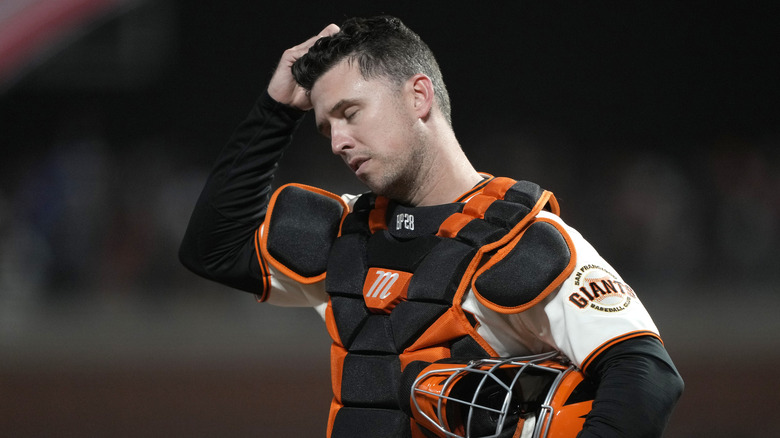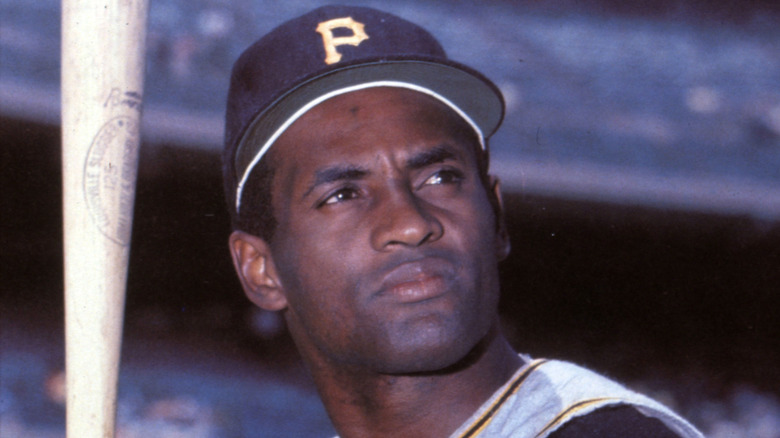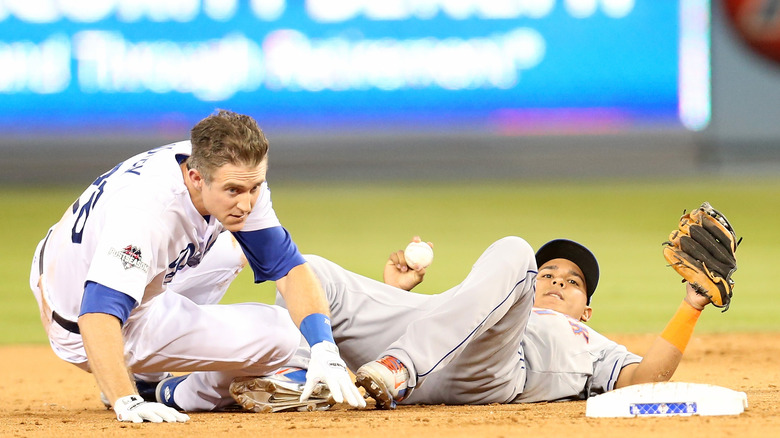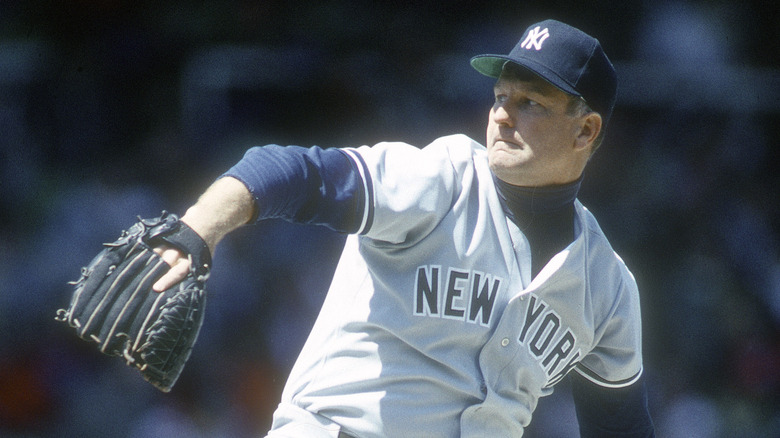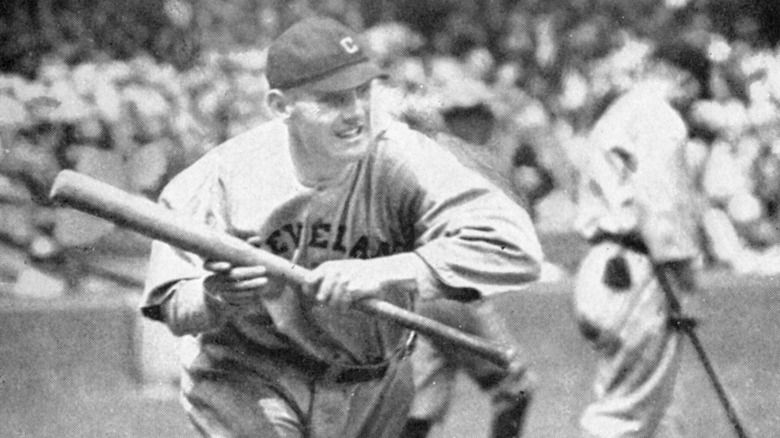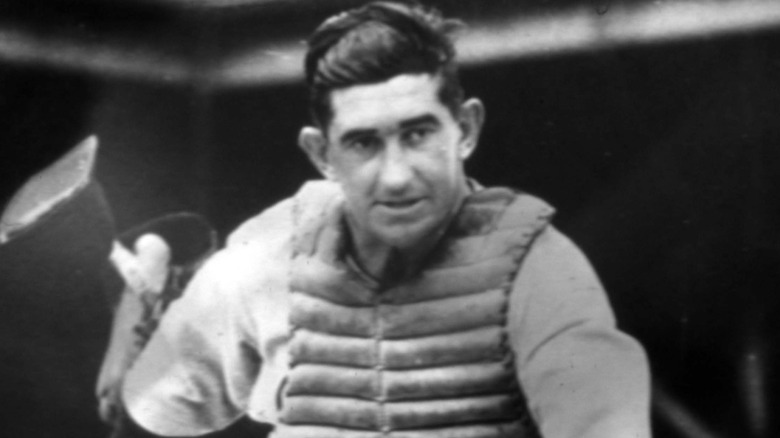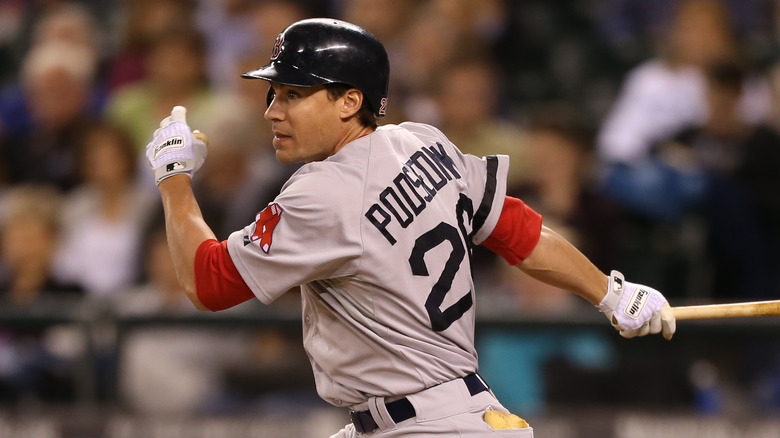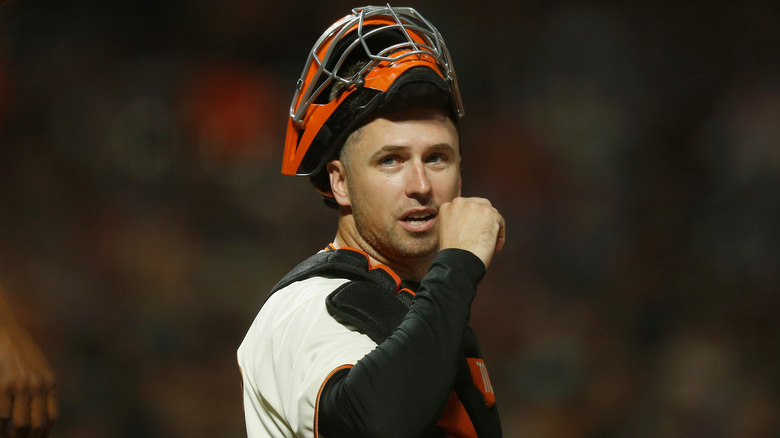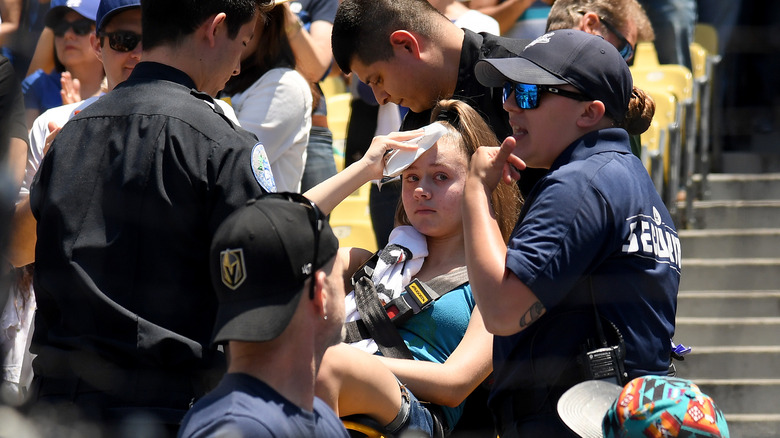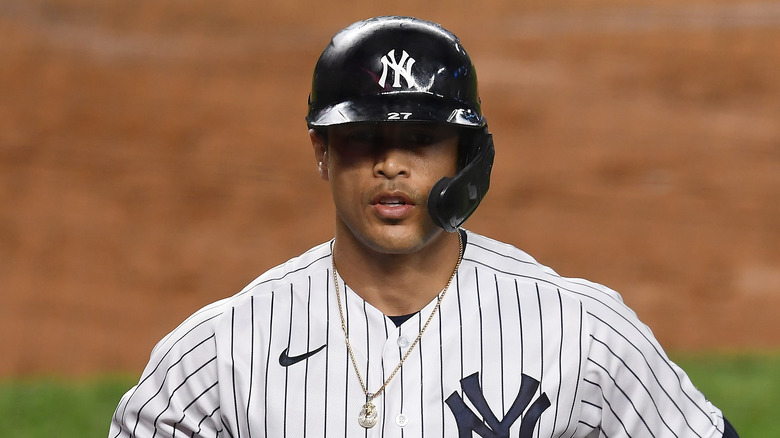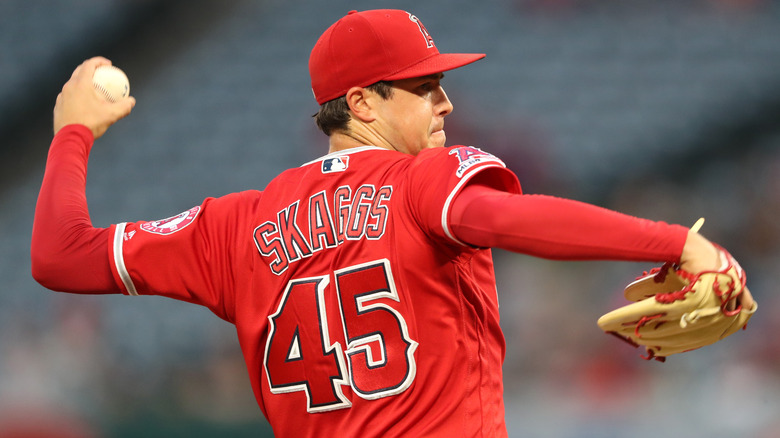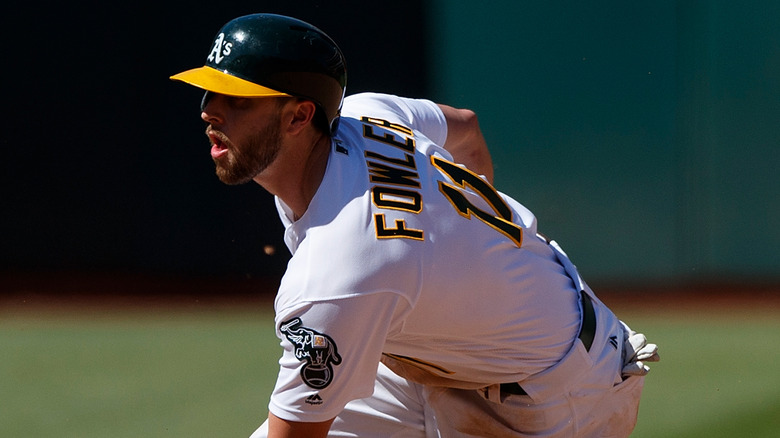Tragedies That Changed The MLB Forever
We may receive a commission on purchases made from links.
The game of baseball has seen its share of rule changes, policy switches, and evolutions over its inception more than 140 years in existence. From the number of balls to achieve a walk to the advent of the infield fly rule or the introduction of the designated hitter in 1973, the game has continued to move forwards as the decades have passed (via Baseball Almanac). But sometimes big changes aren't just attempts to speed up the game or make it more fair to its participants, but are prompted by horrific tragedies on and off the field.
A number of such terrible events have impacted the game and altered it forever. From devastating injuries to superstar players, to tragic deaths of spectators, some of these tragedies have forced the sport to reexamine the rules or change policies in an effort to ensure the safety and longevity of players and fans alike. It's up to Major League Baseball to work towards making the game safer and more equitable for all who love it, and to make sure that tragedies in the game can have a positive impact. This is a list of tragic events that reshaped MLB forever.
Roberto Clemente's death established award
A trailblazing Latin American player, Roberto Clemente would play in 15 All-Star Games, win 12 Gold Gloves, and lead the league in batting average four times (via Basebeball-Reference). With a lifetime average of .317 and over 1300 stolen bases, he was a shoe-in for the Hall of Fame, and at age 37, was still amassing incredible stats. But Clemente's career would be cut short in devastating fashion when the star outfielder was killed in a tragic plane crash (via History).
More than just an exemplary baseball player, Clemente was a beloved humanitarian, which made it all the more shocking when on a flight to Nicaragua to deliver needed aid, his plane went down, taking the lives of all five people aboard. It was a huge loss for baseball not just on the field but off it too, as Clemente's status was one of the game's greatest ambassadors. In the wake of the tragedy, Cooperstown would waive the five-year waiting period and put Clemente into the Hall of Fame just three months after his death. In his honor the league would establish The Roberto Clemente Award, an honor given out once annually to the player who "best exemplifies the game of baseball, sportsmanship, community involvement and the individual's contribution to his team" (via MLB.com)
Though many players before him had used their star power to do good in their communities, Clemente changed the game and how it pushed its best players to have a positive impact off the field.
Chase Utley's dirty slide changed baserunning forever
In 2015, the New York Mets hadn't appeared in a World Series for 15 years and hadn't won one in twice as long, as per Britannica. And while they'd reach the fall classic that season, their chances to take the title took a hit when the team lost utility player Ruben Tejada in the National League Division Series after a nasty slide by runner Chase Utley of the Los Angeles Dodger snapped the infielder's leg (via MLB.com). Though Utley would defend the move, as per USA Today, many felt it was a dirty slide, including Tejada himself (via Sporting New), who felt the controversial Utley had intentionally injured him to break up the double play.
While the Mets would go on to defeat the Dodgers in the Division Series (via MLB), the game would never be the same again. In February of the next year, the MLB made drastic changes to its base-running rules, outlawing aggressive slides in an attempt to avoid a repeat incident like the one seen in 2015, reports the Los Angeles Times. No longer would runners be allowed to kick, shove, or use their bodies to make intentional contact with the fielder in an effort to break up a play, nor would they be permitted to run towards a fielder if they were out of the baseline. A stark difference from the loose base-running etiquette of old, the change became known as "The Utley Rule," notes the Los Angeles Times.
Tommy John injury led to ground-breaking surgery
In 1974, Tommy John was a starting pitcher for the Los Angeles Dodgers where he'd amassed a 13-3 record and a 2.59 earned run average (ERA) (via Baseball-Reference). But after pitching against the Montreal Expos late July, John would pull himself from the game after just two innings. He was later diagnosed with a serious sprain that would require a month's rest, notes Bleacher Report. Unfortunately, after several weeks he wasn't getting better, and it looked like it might be the end of his career when Dr. Frank Jobe offered him a chance to return to baseball with a risky surgery to reconstruct his damaged elbow. The ligament replacement procedure that followed is now referred to as "Tommy John Surgery."
John would return to the mound in 1976 and play for 14 more years, including parts of seven seasons with the New York Yankees, before retiring at the age of 46. While arguably some of his best seasons came after his elbow was rebuilt by Jobe, the biggest impact on the game didn't come in games he pitched. Since 1975, hundreds of players have successfully undergone the procedure, reports HowTheyPlay, and Tommy John surgery has now become fairly routine, with the number of surgeries only increasing in recent years. While some have voiced concerns over its affects on young players, notes Sports Illustrated, it's hard to deny that it's changed the game by extending careers for many.
Ray Chapman's death altered pitching forever
Perhaps one of the most horrible tragedies was the death of Ray Chapman in 1920. A shortstop for the Cleveland Indians since 1912 (when they were known as the Cleveland Naps, as per Baseball-Reference), Chapman was a longtime stalwart of the team and had a reputation as a respected sportsman. But tragedy struck in a game against the New York Yankees on August 16, when a spitball from pitcher Carl Mays sailed up and in and struck Chapman in the head. Reports at the time noted that Chapman hadn't reacted as the pitch moved towards his head, and that Mays instinctively fielded the ball and threw to first for the out (via New York Times). But the umpire immediately called for the team doctors, and Chapman was rushed to the hospital, where he would die from his injury several hours later.
While Chapman's death didn't lead to the advent of hard batting helmets as one might expect, it did have long-term effects put into place shortly after it occurred. The spitball, the controversial pitch that had killed Chapman, was banned as a result of the beaning (via Bleacher Report). The pitch known for its erratic movement was the result of pitchers altering the ball — like with saliva — while on the mound to create its signature unpredictability. It also prompted the league to institute new rules that required umpires to switch out dirty or scuffed balls in between pitches.
Mickey Cochrane's head injury promotes use of helmets
In the wake of the death of Ray Chapman, there was surprisingly little widespread call for batting helmets, though the Indians themselves, rocked by the tragedy, did test out leather batting helmets reminiscent of what football players were using at the time (via The New York Post). But in 1937, even leather headgear was not in regular use when Mickey Cochrane stepped to the plate in a game against the New York Yankees' Bump Hadley. Struck in the head by a pitch, the future Hall of Famer would never return to play in a game again, reports the Baseball Hall of Fame. While the pitch thankfully didn't kill Cochrane, it ended his career, and calls for batting helmets became louder.
Still, even Yankees manager Joe McCarthy criticized the use of helmets, insisting in a comment to the Daily News in 1938 (via RIP Baseball) that players who wore them wouldn't "make any winning teams." Though it would still be decades before batting helmets became mandatory, Cochrane's injury would increase the use of helmets around the sport, with Brooklyn instituting the first mandatory use of protective headgear in 1941, as per the New York Post, and the Dodgers instituting a team policy that saw all batters using specially designed helmets that included hard plastic around the sides of the head (via Baseball Hall). Lou Gherig said it best about the reluctance to wear protection: "Helmets are a sensible, intelligent idea. That's probably why ball players won't adopt 'em."
Scott Podsednik hand injury starts 'oven mitt' craze
Over the decades players have gone from being almost entirely unprotected on the field, with players and managers decrying the use of helmets, to players now covered nearly head to toe in protective gear, with padding and protection for every part of the body. One more recent innovation came about after an injury to big leaguer Scott Podsednik. The baserunner's "oven mitt," named after its resemblance to a certain kitchen safety glove, was described by Podsednik as a slow evolution.
"I had an injury to my thumb in '03, and I started wearing a hard plastic piece to protect my thumb, for sliding head-first," Podsednik told Uni-watch. "I wore that and had no problems with it until '08, when I ended up breaking my pinkie finger sliding into second base. Then I got with a hand therapist and she came up with this cast to protect all my fingers, including the thumb. She came up with it, it has worked perfectly, and I haven't had any problems since."
Something did happen that he might not have suspected though, with many of his fellow teammates picking up on the idea. Eventually, players on other teams began adopting the glove too after seeing him with the mitt on the bases. Yankees outfielder Brett Gardner began wearing a similar piece of hand protection in 2013, reports the Wall Street Journal, while the Royals' Whit Merrifield followed suit shortly thereafter (via the Kansas City Star). Its since become common for baserunners in recent years.
Buster Posey broke his back, and home plate collisions
Hard-nosed play has been a part of baseball since its inception, with collisions at home being one of the most exciting moments in the sport. Perhaps the most notable is infamous incident when Pete Rose bowled over catcher Ray Fosse in the 1970 All-Star Game (via CBS Sports). But all of that would change after a career-altering injury to Buster Posey of the San Francisco Giants in 2011 that ended his season. The All-Star catcher suffered a broken bone in his left leg and tore three ligaments in his ankle, reports CBS. It wasn't the first injury to a catcher after a collision with a runner at home plate, but it had the biggest impact, as MLB would change the rules for runners coming home the following year.
In 2014, changes were made to help protect catchers in what is now referred to as "The Buster Posey Rule," according to Bleacher Report. Catchers are no longer allowed to block home plate until they have the ball in their position and are required to allow runners from third a path to reach home plate, as per CBS. Likewise, "a runner attempting to score may not deviate from his direct pathway to the plate in order to initiate contact with the catcher (or other player covering home plate)." Though the rule rankled some, most embraced it as a way of avoiding tragic injuries like the one to Posey.
A fan's tragic death altered ballparks forever
Of all the major sports, baseball was the only one to sit its fans close to the field to put them at physical risk of errant throws and hits. Unlike hockey, which used plastic and later plexiglass to separate fans from the players — mostly thanks to an infamous brawl between athletes and spectators in 1979 — only a minimal amount of netting existed in most ballparks around the United States to protect fans from foul balls. Until 2019, most fans had to rely on their wits, reflexes, and the help of surrounding fans to avoid being hit by a stray ball. Though there had been a number of minor injuries sustained by spectators over the years, a rash of incidents in the mid-2010's changed everything for Major League Baseball.
Thanks to a spate of serious injuries that culminated in the death of an older woman at Dodgers stadium during the 2018 season (via People Magazine), the MLB decided to install higher netting to protect fans in the stands from high speed foul balls that often peppered the crowd during a routine game, as per CNBC. Though some ballparks had voluntarily added the higher netting before, it was now a requirement for every stadium and park. And while some purists have criticized the netting for taking away the intimacy of some ballparks, there's no denying the protective barrier and will help prevent more tragedies in the future.
Giancarlo Stanton's brutal hit changed helmets forever
One of the most horrifying on-field injuries of the past decade might be when Marlins star slugger Giancarlo Stanton was hit flush in the face with an 88-mph pitch from Milwaukee Brewer's starter Mike Fiers in 2014. Immediately hitting the ground, the tall outfielder writhed in clear agony before being carted off the field (via the MLB). Stanton would remain out for the rest of the season, but upon his return, he'd be sporting a new kind of helmet that would change protective gear across the sport.
Though it has evolved since he first wore it, the first version of this new helmet, as detailed by ESPN when he debuted it, included a gridiron-style bar that looped around and covered the left side of Stanton's face. Further versions included a professionally molded face guard with protective padding. Its since become a manufactured model by helmet-makers Easton, Under Armor, and Adidas. Dubbed the "C-Flap" helmet, it's become a common option, with fellow big leaguers Bryce Harper, Mike Trout, and Miguel Cabrera opting to use the extra protection even though they've never been victims of the kind of hit that Stanton had been (via ESPN). A more recent variation sported by Phillies star Rhys Hoskins even included the protective face guard on both sides of the helmet for extra protection (via Larry Brown Sports).
Though some have mocked the helmet (via Chicago Tribune), it remains a potentially life-saving measure.
Death of Tyler Skaggs prompted a change to MLB's drug policy
Baseball has seen its share of stunning deaths on and off the field, but few have been as sad and shocking as the drug overdose of Angels' pitcher Tyler Skaggs when he was found dead in his hotel room in the middle of the 2019 season. An autopsy released in August of the same year (via ABC News) ruled the pitcher's death an accident, the result of his use of a toxic mixture of fentanyl, oxycodone, and alcohol. In the aftermath of the tragedy, just before the end of the calendar year in December 2019, Major League Baseball and the MLB Player's Association would agree to major changes in the league's drug enforcement and testing policies.
As ABC News details, under the new rules, MLB would begin testing for opioids, fentanyl, cocaine, and synthetic Tetrahydrocannabinol (otherwise known as THC). According to the guidelines established by the new policy, positive results from a player's test would require them to face a newly established drug treatment board. In addition, both players and staff are now required to attend drug education courses on the dangers of opioids and painkillers. Likewise, a program on the use and application of cannabis became mandatory as well, as the same round of changes led to the previously banned substance being removed from prohibition.
Dustin Fowler's devastating injury could change sports law forever
Drafted in 2013, Dustin Fowler was a highly touted prospect in the Yankees' farm system in 2016 (via MiLB). Though he'd play one game with the Yankees before being traded to the Athletics a year later, he'd never see the batter's box before being shipped out of New York. Making his Major League debut in the outfield in the top of the first inning of a game against the White Sox, Fowler would sustain a brutal injury that would end his season and lead to a chain of events that could see the world of sports law changed forever.
Racing down the line to catch a fly ball off the bat of Jose Abreu, Fowler ran headlong into the wall along the first base line, nearly falling into the stands before limping back onto the field (via Youtube). Fowler would ultimately be removed from the game after suffering a ruptured patella tendon, reports ESPN, after crashing into what turned out to be a concealed electrical box. Unlike most injured players though, Fowler chose to sue the White Sox, accusing the team of negligence in the placement of the equipment. While the White Sox filed for a dismissal, the case was ultimately allowed to move forward in state court. Sheryl Ring, an attorney who covered the case for FanGraphs, noted that Fowler's suit "represents a possible sea change in how tort law will deal with these claims moving forward."
